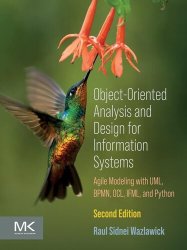 Название: Object-Oriented Analysis and Design for Information Systems: Modeling with BPMN, OCL, IFML, and Python 2nd Edition
Название: Object-Oriented Analysis and Design for Information Systems: Modeling with BPMN, OCL, IFML, and Python 2nd EditionАвтор: Raul Sidnei Wazlawick
Издательство: Morgan Kaufmann/Elsevier
Год: 2024
Страниц: 420
Язык: английский
Формат: epub (true)
Размер: 18.9 MB
Object-Oriented Analysis and Design for Information Systems, Second Edition clearly explains real object-oriented programming in practice. Expert author Raul Sidnei Wazlawick explains concepts such as object responsibility, visibility, and the real need for delegation in detail. The object-oriented code generated by using these concepts in a systematic way is concise, organized and reusable.The patterns and solutions presented in this book are based in research and industrial applications. You will come away with clarity regarding processes and use cases and a clear understanding of how to expand a use case. Wazlawick clearly explains how to build meaningful sequence diagrams. Object-Oriented Analysis and Design for Information Systems illustrates how and why building a class model is not just placing classes into a diagram. You will learn the necessary organizational patterns so that your software architecture will be maintainable. The Second Edition includes all new content shifting the focus of the book to agile software development, including Scrum software project management, BPMN diagrams, user stories, and Python code examples.
What is object-oriented systems development? By observing the way object-oriented analysis and design are taught and practiced in some places, it can be concluded that many professionals simply adopt an object-oriented programming language or use fragments of an object-oriented-based development process without exploring the approach in full. In order to build code that is really object-oriented, developers should learn the techniques of delegation and responsibility assignment, which can lead to reusable code and low coupling. Those techniques are explained in this book.
This chapter presents rules for code generation for the DCD and sequence diagrams. Examples are presented in Python, which is nowadays a dominant language in learning and business. It also has structures that are much closer to those of the algorithms than other languages. DCD classes are usually directly converted into programming language classes. Class attributes are converted into private instance variables in the respective class. In many languages, those variables must be declared. But this is not necessary in Python. As soon as a new identifier is used in the context of a class, it is assumed to be a new instance variable. Although Python does not demand variables to be labeled, any variable has a type that is the type of the object that is stored in the variable.
Provides updates on how to build better class models, which are more maintainable and understandable
Explains how to write use cases in a more efficient and standardized way, using more effective and less complex diagrams
Updates on how to build true object-oriented code with division of responsibility and delegation
Covers contemporary themes such as agile methodologies and BPMN (Business Process Modeling and Notation)
Скачать Object-Oriented Analysis and Design for Information Systems: Modeling with BPMN, OCL, IFML, and Python 2nd Edition